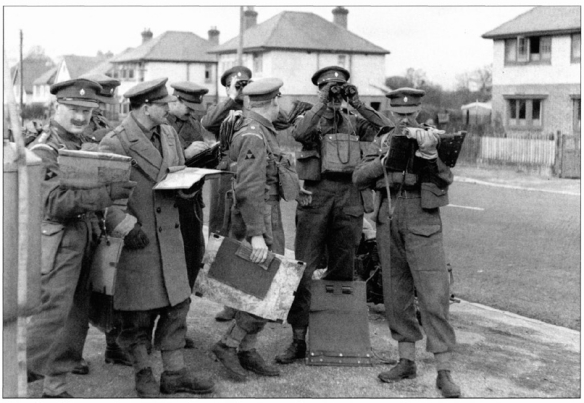
Officers of the Coldstream Guards on a TEWT (Tactical Exercise Without Troops) at Fleet’s Corner, Dorset, in March 1941. (IWM – H8480)
PRIMARY TRAINING CENTRES AND WINGS
Formed under the aegis of the Director of Military Training (MT 2) and later known as the General Service Corps, which came into being in June 1942, it was responsible for most General Military Training (GMT) at Primary Training Centres (PTC). It was at these PTCs that recruits received their initial six weeks basic infantry training, to give them a comprehensive grounding in general military subjects such as drill, rifle and pistol shooting, PT, gas training, elementary map reading and tactics. Recruits were also tested by a ‘personnel selection board’, who decided for which of the arms of the Service each recruit was best suited. Requirements did not always match ‘first choices’, so recruits might well go to a second or even third choice. Some received this training in Primary Training Wings (PTW) attached to Corps Training Centres however; whether at PTC or PTW, the syllabus (devised by the War Office) was common to all. Details of Tests of Elementary Training (TOETs), which were common to all arms.
OFFICER TRAINING
The rapid expansion of the army meant that potential officers had to be selected and trained urgently. At first, the policy was to create numerous small officer cadet units all over the country, where the emphasis was placed more on technical efficiency and physical endurance rather than on character and leadership. After two years, however, it was found that officer production units had to become more homogeneous and were better controlled by a common doctrine from one military training branch in the War Office. Potential Officers (PO) would usually be selected, at the Corps Training Centre stage and sent to a War Office Selection Board (WOSB). If selected, a PO would then go to a pre-OCTU (Officer Cadet Training Unit) where a final decision was made. A PO could spend up to nine weeks there or be sent to OCTU after a week. Others, deemed unsuitable at any time, would be Returned to Unit (RTU). The OCTU course length varied according to the degree of technicality; for example, at an Infantry OCTU it was seventeen weeks, while at the RE OCTU it was thirty weeks.
Staff Training
The enforced expansion also led to a shortage of trained staff officers so more had to be produced in a hurry. However, it was quickly realized that time did not allow the course to be as long as prewar, so merely the essentials were taught. This worked well in practice and students with ability soon excelled. There were three Staff Colleges – at Camberley, Haifa (Palestine) and Quetta (India) – but no Senior Staff College nor Combined Services Staff College, both of which would probably have been an advantage, while a common form of Staff Duties (SD) between the Services did not come into being until after the war.
TECHNICAL TRAINING
It soon became apparent in some of the more technical arms, such as the RAC, RA and REME, that each should have some form of central training establishment, each commanded by a major general (who later became a deputy director under DMT). Their task was to organize all the training of their particular arm and to use all available instructors and equipment so that the instruction was properly co-ordinated and a common policy maintained throughout their arm.